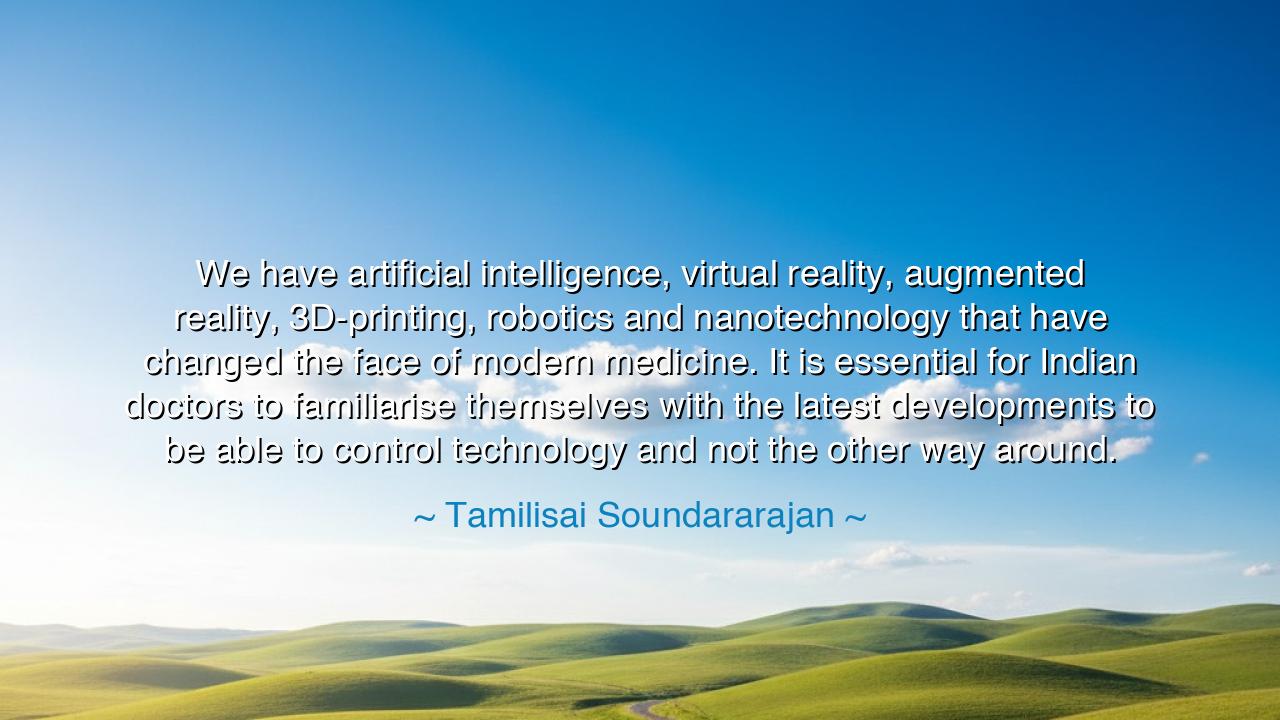
We have artificial intelligence, virtual reality, augmented
We have artificial intelligence, virtual reality, augmented reality, 3D-printing, robotics and nanotechnology that have changed the face of modern medicine. It is essential for Indian doctors to familiarise themselves with the latest developments to be able to control technology and not the other way around.






The Keeper’s Wisdom: Man and the Machines of Healing
In the dawn of a new age, when light and code merge to form the arteries of progress, the voice of Tamilisai Soundararajan rings out like that of an ancient guardian of wisdom: “We have artificial intelligence, virtual reality, augmented reality, 3D-printing, robotics, and nanotechnology that have changed the face of modern medicine. It is essential for Indian doctors to familiarise themselves with the latest developments to be able to control technology and not the other way around.” These words are not mere counsel—they are a warning and a prophecy, reminding humankind that the tools of the future must remain in service of the human spirit, not its master.
The origin of this declaration springs from the heart of modern India, a land where ancient healing once met the sacred, and now meets the digital. Tamilisai Soundararajan, a physician, scholar, and leader, stands at the crossroads of two eras: one of tradition, the other of transformation. She has seen the world of medicine evolve from the stethoscope to the silicon, from the steady hand of the surgeon to the precision of the robotic arm. Yet she reminds her people—especially those who heal—that knowledge, no matter how advanced, must always be guided by wisdom. The physician must not become a servant of his machines, but their master.
In her words echoes the eternal struggle between creation and control, between the maker and the made. Since the time of Prometheus, who brought fire to mankind, humans have wrestled with their own inventions. Fire warmed the home but also burned the fields; steel built civilizations but also forged weapons. So too now, the fire of technology blazes brighter than ever, illuminating the path of healing while threatening to blind those who forget its nature. To “control technology and not the other way around” is to remember that all instruments—whether of flame, steel, or code—exist for the sake of life, not power.
In the realm of medicine, this truth is sacred. Artificial intelligence can diagnose diseases faster than the human eye; 3D-printing can create limbs, bones, and organs once thought irreplaceable; nanotechnology can enter the bloodstream like silent warriors, repairing what time has broken. Yet none of these can replace the compassion of a doctor’s heart or the moral judgment of a healing mind. A machine may measure pain, but it cannot feel it. A code may detect death, but it cannot grieve. It is the human hand, guided by empathy, that gives technology its meaning. Without that balance, medicine becomes a mechanism, and the healer becomes a mechanic of flesh.
The ancients knew that every instrument of power must be tempered by virtue. When Da Vinci designed his flying machines and war engines, he wrote alongside them prayers and reflections, fearing that human curiosity without conscience would lead to ruin. When Hippocrates, the father of medicine, took his sacred oath, it was to remind every healer that skill without mercy is a path to corruption. So too does Tamilisai Soundararajan speak as a modern oracle—calling upon the healers of India, and of the world, to embrace progress but never to abandon principle.
Her warning is already visible in the world around us. There are hospitals that now trust machines more than minds, where screens flicker while patients fade unnoticed. There are algorithms that decide who receives care and who does not, based not on humanity but on data. In such times, her words become not advice but commandment: that the healer must rise above dependency, using these tools as extensions of the soul, not as replacements for it. To yield one’s judgment to a machine is to forget the divine spark that made humanity capable of invention in the first place.
Therefore, let this lesson be carried into the hearts of all who listen: learn the technologies of your age, but master them with conscience. The wise do not shun progress, nor do they bow before it. They walk beside it, holding it steady with the reins of reason and the touch of compassion. If doctors and scientists remember that they are keepers of life, not servants of power, then the marriage of man and machine will not enslave us—it will liberate us.
For as Tamilisai Soundararajan teaches, the true healer is not the one who wields the most advanced instrument, but the one whose heart commands it. Let every physician, every thinker, every dreamer take heed: technology is a faithful servant, but a dangerous master. Keep it in your hand, not in your soul, and the age of intelligence will not eclipse humanity—it will illuminate it.






AAdministratorAdministrator
Welcome, honored guests. Please leave a comment, we will respond soon